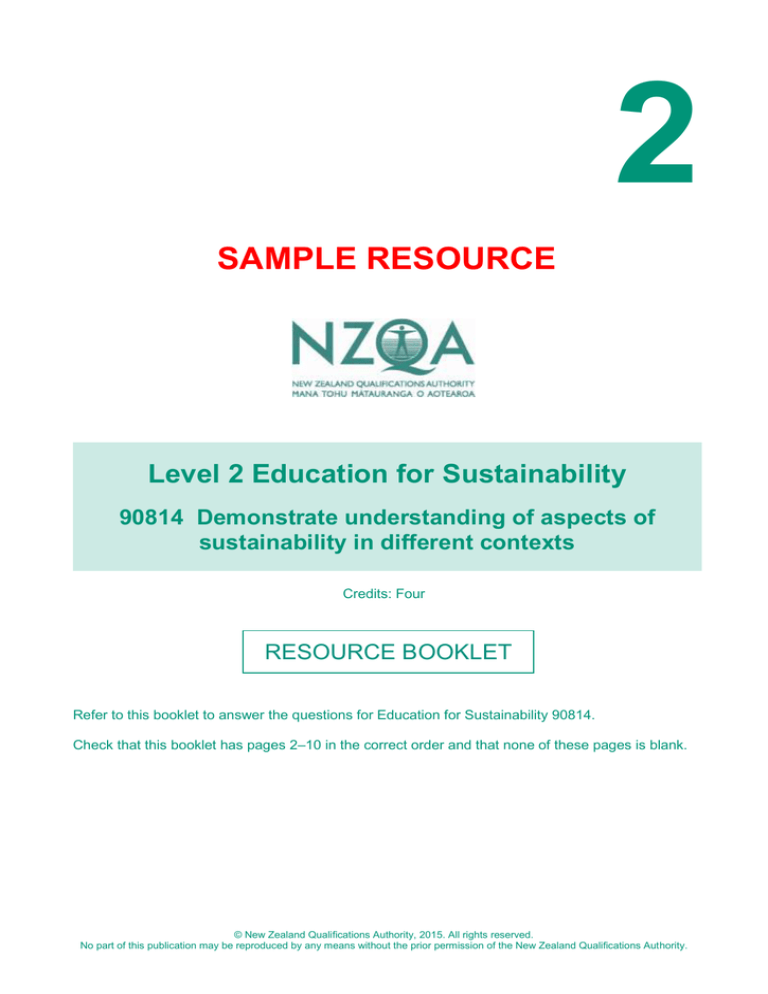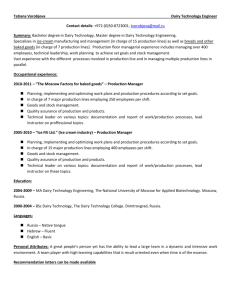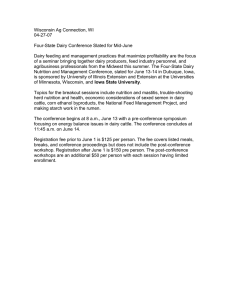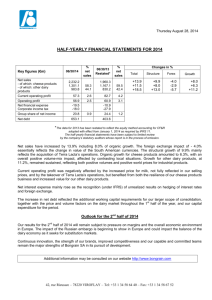
2
SAMPLE RESOURCE
Level 2 Education for Sustainability
90814 Demonstrate understanding of aspects of
sustainability in different contexts
Credits: Four
RESOURCE BOOKLET
Refer to this booklet to answer the questions for Education for Sustainability 90814.
Check that this booklet has pages 2–10 in the correct order and that none of these pages is blank.
© New Zealand Qualifications Authority, 2015. All rights reserved.
No part of this publication may be reproduced by any means without the prior permission of the New Zealand Qualifications Authority.
2
Resource A: Sustainable dairy farming
Environmental stewardship (kaitiakitanga) means
responsible use and protection of the natural
environment through sustainable practices and
conservation. Wise use of resources means using them
sustainably for the greatest good.
Many dairy farmers have planted riparian zones of
native vegetation on their farms to protect sensitive
waterways and wetlands.
National prosperity
New Zealand ranks as the fifth most prosperous nation in the world according to the 2013
Legatum Prosperity Index. For many years, dairy farming has been a key driver of the New
Zealand economy – contributing to more than 25 per cent of export earnings.
There is still considerable scope for dairying to contribute more to the economy through increased
production, higher value milk, and value-added dairy processing. However, New Zealanders have
made it clear in recent times that such growth must be achieved responsibly and not, for example,
at the expense of the environment.
Collectively, the dairy farming industry contributes substantially to New Zealand’s economic
prosperity.
This is highlighted in the following statistics:
Over $13 billion in dairy exports in 2012, the largest of any goods sector and more than 25 per
cent of total goods exports
$5 billion contribution to national Gross Domestic Product (GDP), more than a third of the
entire primary sector
Employs approximately 45 000 people including approximately 10 000 self-employed.
Sustainable dairying
Dairy farming needs to be seen to work for all New Zealanders. Dairy farming needs to be both
competitive and responsible. This means being competitive in a local and global sense – and
responsible today and tomorrow. This responsibility is particularly important with regard to the
natural environment.
The Water Accord
The purpose of this accord is to enhance the overall
performance of dairy farming as it affects freshwater
by:
Committing to good management practices
expected of all dairy farmers in New Zealand.
Recording pledges by the dairy sector, with the
support of others, to assist and encourage dairy
farmers to adopt those good management practices
and to monitor and report progress.
Riparian zone with some evidence of planting
3
Riparian management expectations
Dairy farms will exclude dairy cattle from significant waterways and significant wetlands
using fencing.
Riparian planting will occur where it would provide a water quality benefit.
The crossing of waterways by dairy cows will not result in degradation of those waterways.
Cross-section of planted
riparian zone that is protected
from dairy cows by fencing
Dairy companies will:
Implement measures to exclude dairy cattle from waterways and drains greater than one metre
in width and deeper than 30 cm and significant wetlands on dairy farms according to the
phase-in timetable between May 2014 and May 2017.
Encourage dairy farmers to exclude dairy cattle from all wetlands and apply the stock
exclusion commitment to third party grazing land as if it were their own land.
Implement measures to ensure 100 per cent of regular stock crossing points are either bridged
or culverted by 31 May 2018.
Introduce measures to achieve progressive riparian planting of the length of waterways within
or bounding dairy farms from which there is stock exclusion, where riparian planting will
contribute to water quality enhancement according to the phase-in schedule of riparian
management plans between 2014 and 2030.
Promote and facilitate (including through partnerships with other organisations) riparian
planting to enhance ecosystem health (ongoing).
Nutrient management
Dairy farmers will manage nitrogen (N) and phosphorus (P) loss from dairy farming systems,
acknowledge the need to manage within nutrient loss limits and pursue continuous improvement
in nutrient use efficiency.
DairyNZ will develop an audited nitrogen management system that will enable dairy companies
to model nitrogen loss on supplier dairy farms in a robust manner according to agreed protocols
and consistent data collection systems.
Effluent management expectations
Dairy farms will comply with regional council effluent management rules and/or resource
consent conditions.
Effluent systems installed on dairy farms will be fit for purpose and able to achieve 365-day
compliance with applicable rules.
Introduce programmes to reduce reliance on discharges to water from two-pond Farm Dairy
Effluent (FDE) treatment systems in areas where land application would result in improved
4
water quality outcomes by 31 May 2014.
Looking ahead
The following diagram showing dairy industry objectives provides a broader view of making
dairy farming work for everyone as we go forward:
Achievements
In accordance with the original 2003 Clean Streams Accord, dairy cattle are now excluded from
87 per cent of streams, rivers and lakes. Ninety-nine per cent of race crossings now have
bridges or culverts.
Ninety-nine per cent of dairy farms have nutrient budgets in place, and 56 per cent have
nutrient management plans.
A warrant-of-fitness system for dairy effluent management systems has been developed, with
training and accreditation systems for rural professionals to support farmers’ management of
dairy effluent.
Dairy farm effluent non-compliance is less than 10 per cent nationally.
Research for reducing greenhouse gas emissions from housed wintering systems has been
completed as the basis for a good practice guide.
Dairy companies are implementing supplier agreements aligned with achieving sustainable
dairying (e.g. Fonterra’s Supply Fonterra and Synlait’s Lead with Pride internationally accredited
dairy farm assurance).
5
Source (adapted) and images: Strategy for Sustainable Dairy Farming and Sustainable Dairying: Water Accord.
http://www.dairynz.co.nz
6
Resource B: Habitat restoration – Whau River
The Whau River, its streams and surrounding environment is an example of how urban
waterways can become degraded by human activity. Fifty years ago, the river and its streams
teemed with fish, played host to migratory birds that fed and roosted there, and its banks were
covered in native vegetation. Now this city landscape in Auckland is in trouble.
Cultural perspectives on habitat restoration
The streams and creeks that flow into the Whau have been important to Māori for centuries. Te
Whau, the Māori name for the tidal stream flowing into the Waitemata Habour, provided access
between the Waitemata and Manukau harbours, and the forests that existed in this area provided
the trees from which local Māori built their canoes.
Māori view water and other natural resources as taonga (treasure) with spiritual and metaphysical
properties. These properties, both practical and spiritual, are bound together within the mauri
(life-force) that empowers all living
things, makes people a part of the
natural world, and is central to the
mana and lifeblood of iwi, hapū,
and whānau.
When Pākehā talk about restoring
the health of streams and rivers
they often talk in terms of
ecological health. In Māori terms,
this is expressed as restoring the
mauri. Both viewpoints serve to
protect our streams and rivers.
Settlement of the Whau area
The impact of population growth has seriously affected the health of the river. In 1890 there were
only 29 buildings in New Lynn, a suburb bordering on the Whau River in the north, and most of
the surrounding area was farmland. However, the expansion of the rail network and New Lynn’s
development as an industrial centre kick-started a population growth which continues today.
There are more than 64,000 people living in the Whau catchment area and this figure will probably
double within the next 20 years. We can no longer swim in, fish, or enjoy many parts of the river
the way we used to. As more people have moved into the area, fewer native plants and animals
are found in or around the area. For many locals the river has become the “dirty old Whau” and its
streams “grotty” patches of water they try to ignore in their backyard.
Pollution and the Whau
Most of the pollution that enters the Whau does
so through stormwater. With development
there is less land for rain to permeate, so excess
water becomes stormwater run-off.
Automobiles are responsible for heavy metals
such as copper, lead, and zinc which are
derived from petroleum-based products.
Heavy metals come off tyres, brakes, engines,
oils, rust and exhaust fumes. As soon as it rains,
they are washed off the roads and straight into
the waterways.
Housing development along banks of the Whau River
7
Sediment, or silt, comes from cleared ground, erosion, landslides and building sites. Sediment
smothers creatures and affects the light source that plants need to grow. In high concentrations
sediment can:
irritate gills of fish
bury and suffocate fish eggs
dislodge plants, invertebrates and insects in the stream bed, reducing the food sources of fish.
The early stages of development such as excavation for new subdivisions contribute the biggest
source of sediment. Sediment run-off is a natural process, even from stable native forests, but
human activity in the area dramatically increases the amount of sediment produced.
Oils, paints, detergents and other chemicals
Paints have many ingredients that are dangerous to stream and river life, such as lead, zinc,
cadmium, chromium and mercury. Detergents used in car washes add phosphates and nitrates
that use up lots of oxygen as they biodegrade. Even biodegradable products can pollute
waterways and take the oxygen out of the water as they biodegrade. Oils coat the surface, stopping
oxygen getting into the water. Without this oxygen the fish suffocate.
Looking to the future
One way to create a healthy ecosystem is by replanting appropriate native vegetation alongside
streams and riverbanks. A continuous edge of overhanging plants from long grasses and trees
form shade which keeps the water cool for stream life. Stable banks planted with appropriate
vegetation bind the soil and minimise run-off. A buffer zone of native vegetation each side of the
riverbank provides a habitat for birds, lizards, and other wildlife.
Residents with houses neighbouring the
streams and river have the most to gain by
caring for the streambanks and can do a lot
to help. Cleaning up the Whau not only
improves property values but makes its
streams an asset and not a liability. Quality
of life is improved now and in the future if
the river is safer and healthier.
However, if we are serious about
protecting the Whau then both individual
and community action is needed. The task
is easier with others and we can invite our
neighbours, families and friends to get
involved in cleaning up the Whau. We
need leaders – people to develop the vision
Riparian zone planting along banks of the Whau River
of how healthy our streams and river could
be – to stand up and excite others with that vision. Some Whau residents are already taking action
by joining the Friends of the Whau community group and taking part in initiatives like Wai Care.
It is impossible for us to turn back the clock completely. It is unrealistic to think we can have
absolutely pure waterways when cities and industries have been built on their banks. However, it
is possible to safeguard what we have left by not making the problem worse and by working
individually and communally alongside our local and regional councils to improve our water
quality and ensure the Whau retains its mauri/life-force.
8
Source (adapted) and images: The Whau, our streams, our river, our backyards.
http://www.waitakere.govt.nz/abtcit/ei/pdfs/environment/thewhau.pdf
9
Resource C: Sustainable fishing
New Zealand’s oceans
New Zealand has one of the largest marine areas in the world, covering more than 1 per cent of the
Earth’s surface and 23 times our land area. The marine areas of the New Zealand Exclusive
Economic Zone (EEZ) and extended continental shelf are incredibly diverse. They range from the
subtropical oceans in the north, to temperate waters around the mainland and cool subantarctic
waters in the south.
Many of our marine species are
found nowhere else in the world.
Scientists estimate that more than
80 per cent of New Zealand’s
biodiversity is found in our oceans
and much more is yet to be
discovered. About 17 135 marine
species are known from New
Zealand including some 4315
undescribed species in collections.
The total number of species in the
New Zealand marine environment
could be well over 100 000 species.
Our marine area is also a vital part
of our economy, supporting our
$1.5 billion fishing industry and
our $20 billion tourism industry.
Royal albatross on the South Pacific Ocean near Dunedin
It is also central to our national identity: most New Zealanders live near the ocean and have a close
relationship with the marine environment. We collect kiamoana (seafood), swim, surf, dive,
snorkel and sail, and appreciate the variety of life in our marine environment.
New Zealand currently has 34 marine reserves (no-take areas), yet less than 1 per cent of New
Zealand’s marine environment is fully protected.
Oceans under threat
New Zealand’s marine environment is under increasing pressure from human activities. Climate
change, pollution, coastal development, mineral exploration and mining create cumulative effects
that are having a detrimental impact on the health of the marine environment and marine life.
Fishing operations have the most significant impact on the marine environment, both through the
amount of fish caught and the methods used to catch it.
Some fishing practices, such as bottom trawling and dredging, used by fisheries in New Zealand
waters damage the marine environment.
Over the last 50 years, fishing technologies have developed to such an extent that the scale of
fishing operations now exceeds a level that is sustainable. The United Nations estimates that
70 per cent of the world’s fisheries are now exploited to their limits, over-exploited or depleted.
10
Many fishing operations result in significant levels of bycatch – species such as albatrosses,
dolphins, sea lions and other non-target species.
According to Statistics New Zealand,
fishing uses more energy as a
proportion of total costs than any other
industry sector, increasing by 40
per cent in the last decade in terms of
environmental cost.
New Zealand prides itself on our clean,
green image and promotes its fisheries
management as world-leading.
Compared to some fisheries, this is
partly true – New Zealand does take a
comprehensive management approach
that is recognised as being among the
best. But comparing ourselves to
countries with no or very poor fisheries
management does not mean that we
New Zealand sea lion mother and pup on Otago Peninsula
should be proud of our situation.
New Zealand is still far from living up to its slogan “If it’s from New Zealand, it’s sustainable.”
Fisheries for wild species typically take place in open waters, with low levels of enforcement of
rules that aim to ensure sustainability and few observers to report any breaches or problems.
New Zealand’s fisheries quota management system (QMS) is a rights-based system that entitles
quota holders to a ‘right to fish’, which encourages them to fish to the maximum level allowed
under their quota, rather than take a more sustainable approach.
To ensure sustainability, the QMS requires good information and a precautionary approach.
Fisheries management in New Zealand is failing by:
Allowing significant waste of fisheries resources.
Having no upper size limit and allowing fish that have gathered to spawn to be caught,
reducing the ability of fish populations to reproduce.
Targeting the maximum (rather than an optimum or precautionary) yield.
Lacking information about fish stocks and how sustainable catches are.
Allowing or poorly managing levels of marine mammal and seabird deaths, including
endangered species.
Using destructive fishing techniques, such as bottom trawling and dredging, which destroy
habitats and seabed life.
11
Our vision
Forest & Bird has a vision for a more sustainable fishery by 2030:
A healthy and diverse marine environment supporting an abundance of marine life, where
profitable fisheries operate alongside other activities.
Adverse impacts of fishing on the marine environment have been minimised or mitigated, and
‘nursery areas’ – important for replenishment of populations – are fully protected within
marine reserves.
New Zealand meets or exceeds the world’s best practice in fisheries management and
environmental practice, so it can market truly sustainable products worldwide.
Forest & Bird hopes that making seafood consumers aware of the problems behind our
fisheries management will help them make better choices and encourage our fisheries to
improve their practices.
Source (adapted) and images: http://www. forestandbird.org.nz
Source (cartoon image): http://plantbaseddietitian.com/wp-content/uploads/2013/09/give-a-man-a-fish1.jpg




